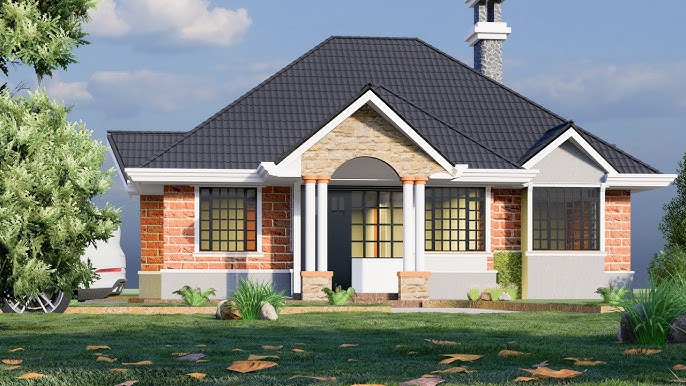Building a home is a multi-step process, with budgeting for each stage being essential for success. Among these stages, roofing plays a critical role, not just in providing shelter but also in determining the aesthetic appeal of the home. This article will focus on the cost of roofing a 3-bedroom house in Kenya, covering the key factors that influence these costs and tips for selecting quality materials to ensure a durable roof.
Estimated Cost of Roofing a 3-Bedroom House in Kenya
Roofing a standard three-bedroom house in Kenya typically starts from approximately Ksh 350,000. This estimate applies to a house with a typical layout, including an entry porch, lounge, dining area, kitchen, pantry, master ensuite bedroom, and common bathroom facilities. However, actual costs may vary depending on the roofing design, materials used, labor costs, and other factors specific to your project.
Factors Affecting the Cost of Roofing a 3-Bedroom House in Kenya
Understanding the key factors that influence roofing costs can help you make informed decisions and budget effectively. Here are the main considerations:
1. Roof Design
The design of your roof plays a significant role in determining the overall cost. Different roof designs have varying material requirements, which can affect your budget. Here are some common designs and their impact on cost:
- Hip Roof: This is one of the most popular designs for modern homes in Kenya. The hip roof design requires more timber for the roof structure, which can increase costs. It offers good stability and is suitable for areas with strong winds.
- Gable Roof: A gable roof is characterized by two sloping sides that meet at a ridge, creating a triangular shape. While it requires more walling materials like building stones and cement, it generally uses less timber compared to a hip roof.
- Flat Roof: This design involves a slightly pitched roof that appears flat. It is often simpler to construct and can be more cost-effective compared to hip and gable roofs. However, if a concrete slab is used, the cost can be higher due to the need for steel reinforcement and concrete.
2. Roofing Materials
The materials you choose for different parts of the roof will greatly impact the total cost. Below are the key parts of a roof and the material choices available:
- Roof Skeleton: This forms the underlying structure of the roof and typically consists of components like wall plates, tie beams, ridge beams, and king posts. In Kenya, timber is the most common material used for the skeleton, but steel beams are also an option, especially for larger structures or areas prone to termites. Steel may be more expensive but offers greater durability.
- Roof Covering: This refers to the topmost layer that provides protection from the elements. Common materials in Kenya include iron sheets and roofing tiles. Iron sheets come in different types such as pre-painted or galvanised, with pre-painted options being more expensive due to their aesthetic appeal and corrosion resistance. Roofing tiles, made from materials like concrete or clay, offer a more elegant look but are costlier and heavier, requiring a stronger skeleton.
- Finishing Materials: Fascia boards, ceiling panels, and painting are part of the finishing touches that enhance the appearance of the roof. Quality materials for these can increase the cost but ensure a polished final look.
3. Labor Costs
Labor is another crucial factor in roofing costs. Depending on the complexity of the roof design and the materials used, you may need to hire different professionals:
- For timber roofs, carpenters are typically engaged.
- For steel structures, a skilled welder is required.
- The average labor cost is usually about 6% of the total materials cost, though this can vary based on the region and expertise level of the workers.
4. Location of the Construction Site
The cost of materials and labor can vary depending on the location of your construction site in Kenya. Transporting materials to remote areas can add to the overall expense. Additionally, building regulations and weather conditions may necessitate specific materials or designs, influencing the total cost.
5. Additional Features and Customizations
Extra features such as rainwater harvesting systems can also impact the cost of roofing. This includes the installation of gutters, downpipes, and storage tanks. While this may increase initial costs, it can provide long-term benefits in terms of water management.
If you have access to your own timber or building materials, this can significantly reduce the overall cost. Additionally, using energy-efficient roofing materials, like insulated iron sheets, can also be an investment that pays off in the long run through energy savings.
Tips for Managing Roofing Costs
- Work with a Professional: To ensure that you get value for your money, always engage experienced professionals in your roofing project. They can provide guidance on suitable materials, designs, and help prevent common mistakes that could lead to higher costs.
- Get Multiple Quotations: When purchasing materials, it is advisable to compare prices from different suppliers. This can help you find the best deals and avoid overpaying for materials.
- Plan for Future Needs: If you plan to add solar panels, water heaters, or other installations in the future, consider this when designing your roof. A sturdy design with adequate space for additional installations can save you costs later on.
- Quality over Cost: Avoid compromising on the quality of materials to cut costs. Investing in high-quality materials ensures durability, reducing the need for repairs and maintenance over time.
Roofing a 3-bedroom house in Kenya is a significant investment that requires careful planning and budgeting. While the average starting cost is around Ksh 350,000, the final amount can vary based on design choices, materials, labor, and additional features. By considering the factors outlined in this guide, you can make informed decisions that balance quality and cost, ensuring a safe and beautiful roof over your head.
Remember, the roof is not only about aesthetics but also about durability and protection for your home. Make sure to consult with professionals and choose materials that suit your needs and preferences. We hope this guide has provided you with valuable insights for your roofing project. Happy building!





